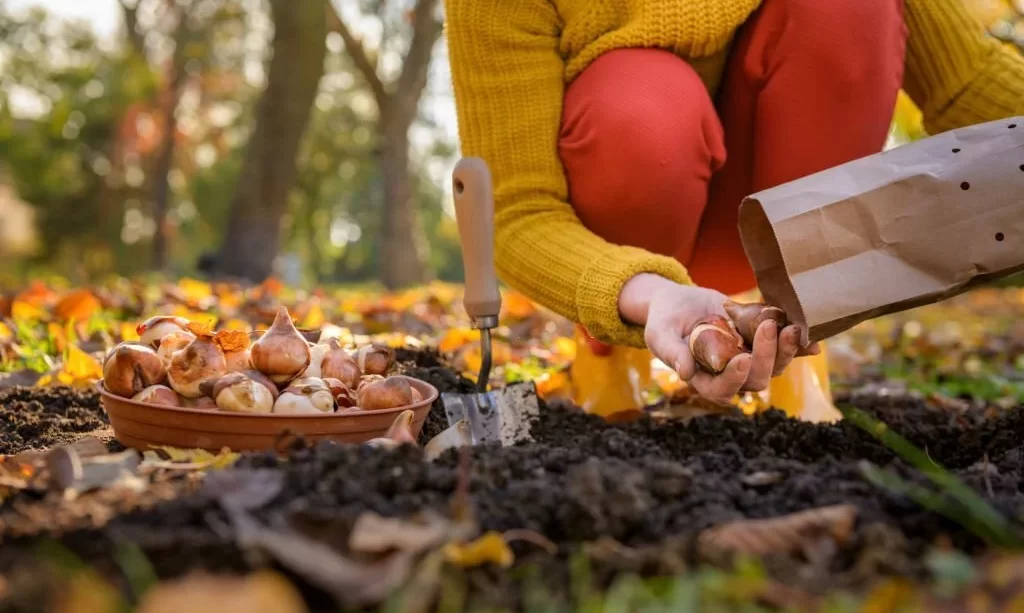Tulips, with their vibrant and elegant blooms, are a cherished sight in spring gardens around the world. These colorful flowers bring joy and beauty to our outdoor spaces but leave many gardeners wondering what to do when their glorious petals begin to fade. It’s a common question: Can you replant tulip bulbs? In this article, we will explore the fascinating world of tulip bulbs and unravel the mystery of how to extend the life of these stunning springtime favorites. Is it possible to breathe new life into tulip bulbs after their showy display has come to an end? Let’s dive into the world of tulips and discover the answers.
- Multi Colors in spring
- EASY & SIMPLE
- Plant now and enjoy in spring
- Nothing special to do
- colorful display of tulips in spring
Tulip Bulbs
To comprehend the art of replanting tulip bulbs, we must first understand the nature of these underground treasures. Tulip bulbs serve as storage structures for the tulip plant. They contain all the necessary nutrients and energy required for the plant’s growth, flowering, and eventual dormancy. The life cycle of a tulip encompasses the growth phase, where the plant sprouts from the bulb, the bloom phase when it produces its spectacular flowers, and finally, the dormancy phase, when the foliage withers, and the bulb goes into a resting state. During dormancy, the tulip bulb conserves energy for the next growing season, patiently waiting for its time to shine once again. It’s this natural cycle that forms the basis for the practice of replanting tulip bulbs, allowing us to enjoy their beauty year after year.
When to Replant Tulip Bulbs
Replanting tulip bulbs is a thoughtful process that requires precise timing. The ideal time for this endeavor is typically in the fall. This timing is crucial for several reasons. First, it allows the tulip bulbs to go through a period of dormancy after their spring bloom. During dormancy, the bulbs rest, rejuvenate, and gather energy for the next growth cycle. Second, fall planting enables the bulbs to establish their root systems before the onset of winter frost. This root development is vital for the tulip’s stability and ability to draw in nutrients from the soil.
By replanting in the fall, you ensure that the tulip bulbs have enough time to settle into their new home and prepare for their magnificent spring display. This practice aligns perfectly with nature’s schedule, ensuring that your tulips bloom with vigor when the warmer months arrive.
- GREEN TULIPS: Rare green tulips are hard to find, and rare in nature.
- FITS ANY SIZE: Ideal for mass planting or in a container. . Beautiful vibrant colors bloom early spring.
- CZ GRAIN GUARANTEE: We Guarantee all our products! Reach out with questions or concerns for a fast and simple solution.
- PLANTING TIPS: Plant 1.5 inches deep in good soil. Tulips can be stored in your fridge for months if you want it to cool off more before planting
Steps for Replanting Tulip Bulbs
Replanting tulip bulbs is a straightforward but essential process to ensure their continued vitality. Here are the key steps:
- Digging Up the Bulbs: After your tulips have finished flowering in the spring, carefully dig up the bulbs. Use a garden fork or trowel to avoid damaging them.
- Cleaning and Inspection: Gently clean the bulbs to remove excess soil and inspect them for any signs of disease or damage. Healthy bulbs should be firm and free from mold or soft spots.
- Selecting a Planting Location: Choose a suitable location in your garden for replanting. Tulips prefer well-draining soil and a spot with partial to full sunlight.
- Soil Preparation: Prepare the soil by adding organic matter to improve drainage and fertility. Remove any weeds or debris from the planting area.
- Protects against over- and under-watering
- Feeds up to 6 months
- Grows plants twice as big (vs. unfed plants)
- Absorbs up to 33 percent more water than basic potting soil (vs. potting soil that does not contain sphagnum peat moss, coir and wetting agent)
- Helps beautify potted flowers, indoors and out
Replanting Tulip Bulbs
Once you have prepared the bulbs and the planting area, it’s time to replant your tulip bulbs:
- Planting Depth: Dig holes in the soil to the appropriate planting depth, typically about three times the height of the bulb. Place the bulbs in the holes with the pointed end facing upwards.
- Spacing: Space the bulbs according to the recommended spacing for the specific tulip variety you are planting. This information is typically provided on the bulb packaging or in gardening guides.
- Watering and Mulching: After planting, water the area thoroughly to settle the soil and provide moisture to the bulbs. Apply a layer of mulch to help conserve moisture and regulate soil temperature.
- Labeling: To keep track of your tulip varieties, consider labeling the planting area or making a garden plan.
By following these steps, you can ensure that your replanted tulip bulbs have the best possible start in their new home. These bulbs will spend the summer months quietly building their strength, ready to burst forth with beautiful blooms when spring arrives once again.
Caring for Replanted Tulip Bulbs
Caring for your replanted tulip bulbs is essential to ensure their health and the success of your future blooms. Here’s how to do it:
- Watering and Fertilizing: During the growing season, provide consistent moisture, especially if the weather is dry. While tulips don’t need excessive watering, they benefit from regular hydration. Applying a balanced, slow-release fertilizer in early spring can also promote healthy growth.
- Weed Control: Keep the area around your tulip bulbs free from weeds. Weeds can compete for nutrients and moisture, which may affect the tulips’ growth.
- Deadheading: After your tulips have finished flowering, remove the faded blooms to prevent seed production. This encourages the tulip to channel its energy into bulb development rather than seed formation.
- Leaving Foliage Intact: Allow the tulip foliage to wither naturally. The leaves continue to photosynthesize and provide energy to the bulb for the next growing season. Trimming or removing the leaves prematurely can weaken the bulb.
- FOR USE ON: Use Bulb-tone organic fertilizer for all Fall bulbs like tulips, daffodils, crocus & hyacinths and on Spring bulbs like gladioli and lilies
- CONTAINS: Bulb-tone is a rich blend of the finest natural & organic ingredients enhanced with our exclusive Bio-tone formula; 3-5-3 Fertilizer analysis with 6% Calcium. Bulb-tone is environmentally Safe – No sludges or toxic ingredients
- WHEN / HOW TO USE: Best to use Bulb-tone fertilizer when planting or feeding post bloom on spring flowering bulbs; place directly in the planting hole for new bulbs and sprinkle on the soil surface for established plants then water thoroughly. Bulb-tone is ready to use and requires no mixing
- FOR ORGANIC GARDENING: Bulb-tone is approved for organic gardening; It is a registered Organic Input Material meaning it meets all requirements for organic production
- MADE IN THE USA: Product of the Espoma Company. The leader in natural organics since 1929
Advantages of Replanting Tulip Bulbs
Replanting tulip bulbs offers numerous advantages for gardeners:
- Economic Savings: Replanting your own tulip bulbs saves money compared to purchasing new bulbs each year. It’s a budget-friendly way to enjoy beautiful spring blooms.
- Improved Blooms: Replanted bulbs often produce larger and more robust blooms as they acclimate to your garden’s conditions over time.
- Perennial Beauty: By replanting, you can create a perennial display of tulips in your garden, ensuring you enjoy their beauty year after year.
- Eco-Friendly: Reusing bulbs is an environmentally conscious practice, reducing the demand for new bulb production and lowering your ecological footprint.
Conclusion
In conclusion, the practice of replanting tulip bulbs is a rewarding endeavor that allows you to extend the life and beauty of these beloved spring flowers. Understanding the bulb’s natural life cycle, selecting the right timing for replanting, and following proper care and maintenance techniques are key to success.
As you nurture your replanted tulip bulbs through the seasons, you’ll witness the fruits of your efforts each spring when they burst into colorful bloom. Whether you choose to replant for economic savings, improved blooms, or the joy of creating a perennial tulip garden, this practice connects you with the timeless beauty of nature and the pleasure of gardening. So, embrace the art of replanting tulip bulbs and relish in the anticipation of their exquisite springtime displays year after year.







